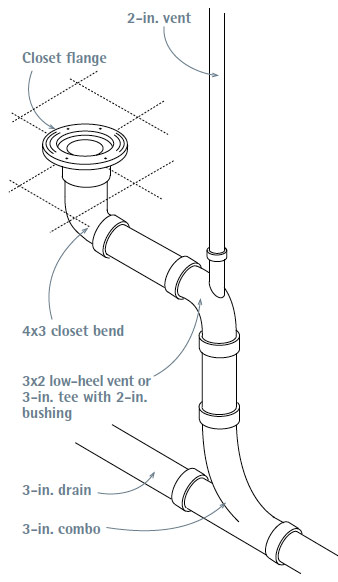Understanding The Significance of Correct Ventilation in Plumbing Systems
Understanding The Significance of Correct Ventilation in Plumbing Systems
Blog Article
This post following next relating to What Is a Plumbing Vent and Why Is It Important is rather enlightening. You should read it.

Proper air flow in plumbing systems is frequently overlooked, yet it is crucial for preserving the capability and security of your home's pipes. Air flow assists control atmospheric pressure, avoid the build-up of hazardous gases, and make sure the reliable removal of waste. In this guide, we will explore the relevance of appropriate pipes ventilation, how it works, and the advantages it offers your pipes system.
Comprehending Air Flow in Pipes
Ventilation in pipes refers to the network of pipelines that allow air to stream via the water drainage system. These vents offer multiple objectives, consisting of managing atmospheric pressure within the pipelines, protecting against sewage system gases from entering the home, and helping in the smooth circulation of wastewater.
Just How Air Flow Works in Plumbing Systems
Atmospheric Pressure Law
Correct air flow maintains balanced air pressure within the pipes system. When water moves with pipes, it displaces air. Without ample air flow, this displacement can create adverse pressure, causing slow drains or siphoning of water from catches, which can trigger unpleasant odors to permeate right into the home.
Preventing Sewer Gas Accumulation
Among the most important functions of pipes vents is to stop sewage system gases, such as methane and hydrogen sulfide, from gathering within the home. These gases can posture significant health threats and are highly flammable. Vent pipelines enable these gases to leave securely outdoors.
Helping in Waste Elimination
Air flow assists in the reliable removal of wastewater by avoiding airlocks in the drain system. When air can flow easily through the vents, it allows water and waste to flow efficiently via the pipes, minimizing the threat of clogs and back-ups.
Sorts Of Pipes Vents
Main Heap Vent
The main pile vent, additionally referred to as the vent stack, is the primary air vent in a pipes system. It prolongs from the primary drainpipe line up through the roof, permitting gases to run away and fresh air to get in the system.
Branch Vent
Branch vents attach to the major stack vent and serve specific components, such as sinks, toilets, and showers. These vents guarantee that each fixture has sufficient ventilation to operate properly.
Air Admittance Shutoff (AAV).
An Air Admittance Valve (AAV) is a one-way valve that enables air to go into the pipes system without the requirement for a typical vent pipeline prolonging through the roof covering. AAVs are commonly made use of in improvements or areas where installing a standard vent is not practical.
Indicators of Poor Air Flow in Pipes.
Slow Draining Fixtures.
If your sinks, bathtubs, or bathrooms are draining gradually, it could be an indicator of poor air flow. Inadequate air flow can create a vacuum impact, making it tough for water to drain pipes correctly.
Gurgling Appears.
Gurgling audios coming from drains pipes are often an outcome of air being sucked with water traps because of unfavorable pressure in the pipelines. This is a clear sign of inadequate ventilation.
Unpleasant Odors.
Sewer odors inside your home are a warning that your pipes system is not properly ventilated. This can suggest that sewage system gases are not being properly aired vent outside, resulting in possibly dangerous problems.
Common Ventilation Blunders.
Inadequate Vent Sizing.
Utilizing small air vent pipelines can cause bad air flow and stress discrepancies in the system. It's important to utilize vents that fulfill the particular needs of your plumbing system.
Improper Vent Positioning.
Placing vents as well much from the fixtures they offer can reduce their efficiency. Proper placement ensures that air can move easily and successfully through the system.
Disregarding Code Requirements.
Building regulations supply certain standards for pipes air flow. Overlooking these codes can cause a system that stops working to operate correctly and might result in costly repair work or carcinogen.
Benefits of Appropriate Air Flow.
Boosted System Efficiency.
Effectively aerated pipes systems run much more efficiently, with fewer blockages, faster draining pipes, and much less strain on the pipes. This effectiveness prolongs the lifespan of the pipes system.
Improved Air Top Quality.
By preventing sewer gases from entering your home, correct ventilation contributes to far better interior air top quality, making your living atmosphere healthier and a lot more comfy.
Avoiding Water Damage.
Ample ventilation aids avoid water from being siphoned out of catches, which can cause drain gases going into the home and triggering water damages gradually.
Steps to Guarantee Proper Ventilation.
Consulting Pipes Codes.
Always speak with neighborhood pipes codes when making or changing your pipes system. These codes give the necessary guidelines for proper airing vent and ensure your system meets safety standards.
Regular Evaluation and Maintenance.
Routine assessments can assist determine possible air flow concerns prior to they become major problems. Upkeep jobs, such as cleansing vent pipes and looking for clogs, are vital for maintaining the system in good working order.
Expert Installment.
For new setups or significant alterations, it's important to work with an expert plumber. They have the experience to ensure the ventilation system is correctly created and mounted according to code.
Conclusion.
Appropriate ventilation is an important element of any type of pipes system, making certain that it operates effectively and securely. By understanding the importance of air flow, recognizing the indications of inadequate air flow, and taking actions to preserve your system, you can avoid expensive problems and shield your home's air high quality.
Understanding the Role of Your Plumbing Vents in the Drainage System
The plumbing system in your home is more than just the kitchen sink, toilet, and bathroom. Some problems that arise within home plumbing are hard to detect because homeowners may not understand potential causes.
One part of the plumbing system that could cause you endless problems is the venting. The drain lines that run through your home and drain wastewater need proper venting to function properly. Faulty plumbing vents can lead to several problems that require the expertise of a plumber to check them out. Before finding experienced plumbing services, there are a few things to learn about plumbing vents.
Why vents are vital
Vents in the plumbing system lead to an outside area such as the roof or the back. The function of these vents is to keep sewer gases away from the drain pipes. They also establish seals in the drainage pipes that prevent the sucking back of waste gases into the home. Venting in the plumbing system also allows oxygen to get into the drainage system, which is an essential component in the breakdown of waste matter. The vents also ensure that the air pressure within the drainage system remains balanced, facilitating the flow of wastewater.
Possible problems
When the plumbing vents are problematic, one of the consequences is imbalanced water levels in the toilet. If you notice that the levels in the toilet bowl rise and fall all the time, then there may be something wrong with the vents.
Another issue is air bubble formation within the toilet. In most cases like these, the drain pipes are not receiving enough air. Lack of air pressure equalization is what leads to water flow problems. If you come across such issues in your home, make sure you call professional plumbers, such as the ones from Perfection Plumbing & Drain Cleaning Ltd.
Potential causes
Several scenarios can lead to some of the plumbing problems that homeowners suffer because of venting. One such scenario is the use of incorrectly sized vents. Usually, vents are the same size as the drain line to facilitate proper venting. Vents that are too small will lead to some plumbing issues. Another potential cause is fixtures that are not close enough to the vents. In this scenario, air forces itself through the traps of other fixtures, leading to gurgling sounds from toilets and sinks.
Most of these problems also happen with clogged vents. Tree leaves and debris can cause clogging when they make their way down a vent. Unclogging plumbing vents is a service that you can entrust to Saskatoon plumbers. They will know how to snake down vents and remove clogging stuck in fixtures.

We were introduced to that report about What Is a Plumbing Vent and Why Is It Important through an acquaintance on our other web page. In case you enjoyed reading our blog post kindly consider to share it. Thank you for your time. Return soon.
Request Service Report this page